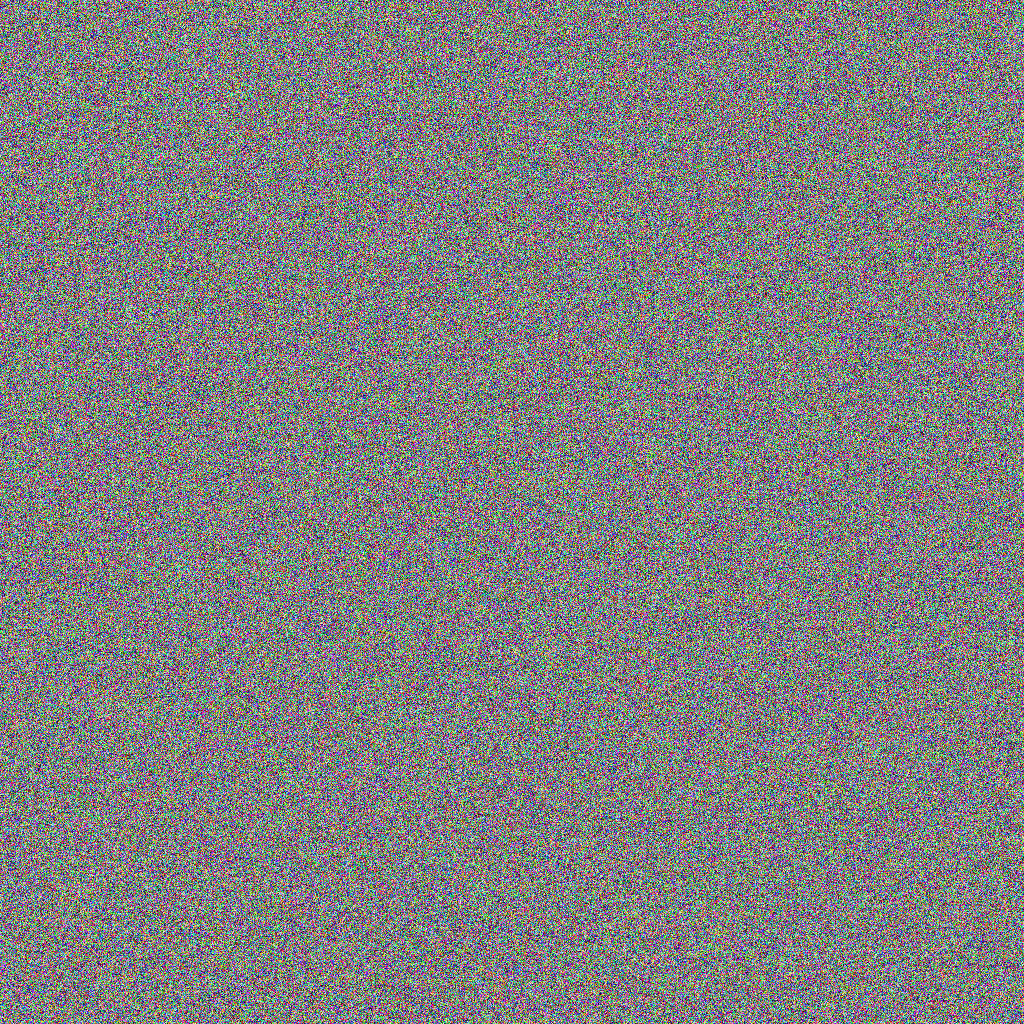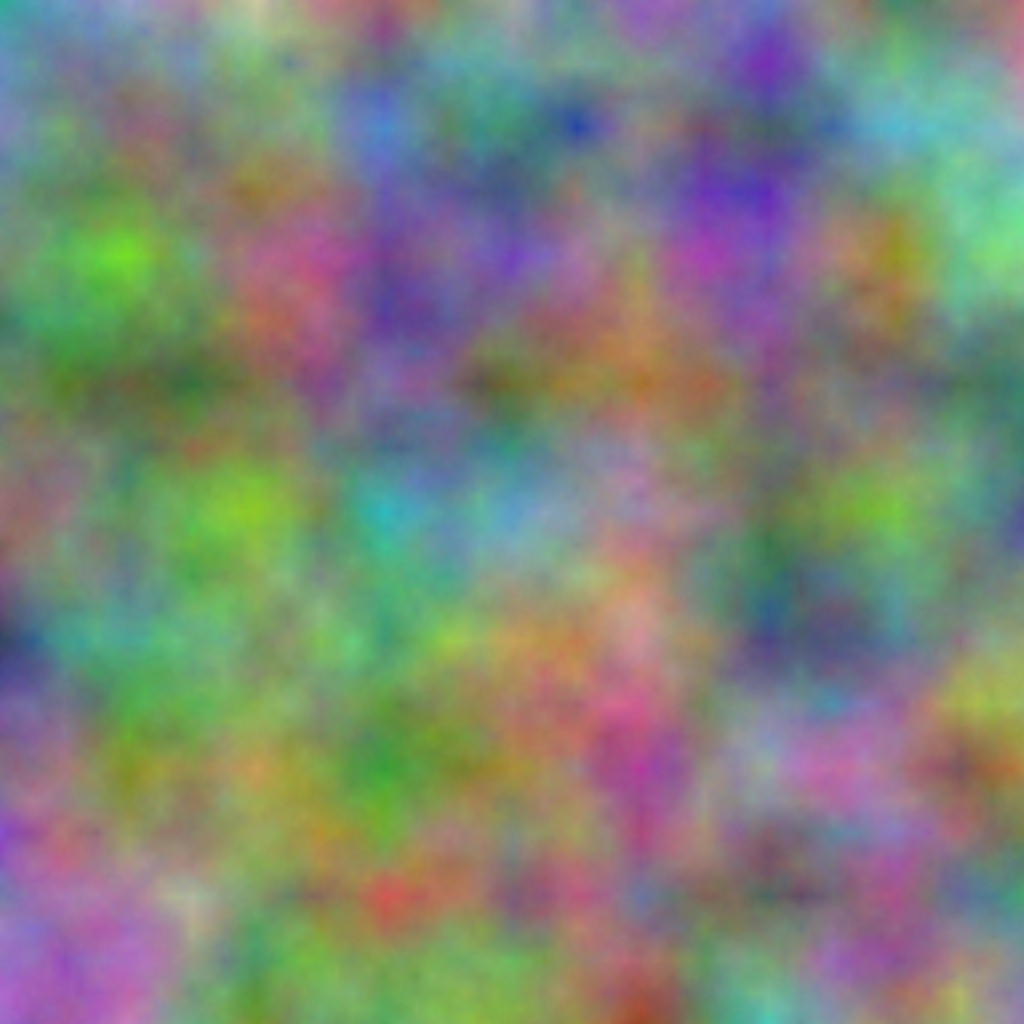Generating Colored Noise
When I talked about generating noise, I only focused on storing the results in the typical grayscale form and ended up just using the same noise value for the R, G, B channels, while setting the A channel to 255.
It should go without saying that it’s perfectly fine and possible to store a separate noise value in each channel and thus have 4 noise textures packed into one.
Let’s see how this looks and works in practice by starting with the typical good old static noise at first.

static void process(
rgba_t *output,
const int w,
const int h
)
{
int i, n, r, g, b, a;
for(i = 0, n = w * h; i < n; i++)
{
r = rand() & 0xFF;
g = rand() & 0xFF;
b = rand() & 0xFF;
a = rand() & 0xFF;
output[i] = (rgba_t) {
.r = r,
.g = g,
.b = b,
.a = a
};
}
}
And now, our friendly neighborhood faux Perlin noise imitation.

#define NOISE_MAX (1 << 14)
#define NOISE_MAX_MASK (NOISE_MAX - 1)
#define NOISE_MAX_MASK_INV (1.0f / (float) NOISE_MAX_MASK)
static void randomize(
float *noise[4],
const int w,
const int h,
const unsigned int seed
)
{
int i, j, n;
for(j = 0; j < 4; j++)
{
srand(seed + j);
for(i = 0, n = w * h; i < n; i++)
{
noise[j][i] = (rand() & NOISE_MAX_MASK) * NOISE_MAX_MASK_INV;
}
}
}
#define fract(a) ((a) - ((int)(a)))
#define lerp(a, b, t) ((1 - (t)) * (a) + (t) * (b))
static void process(
const float *restrict noise[4],
rgba_t *restrict output,
const int w,
const int h,
const int num_samples
)
{
int x, y, i, j, xx0, yy0, xx1, yy1, yyo0, yyo1, yo, ww, hh;
float inv_num_samples, inv_scale, xx, yy, fx, fy;
float ac[4], v0, v1, cr, cg, cb, ca, c0, c1, c2, c3;
ww = w - 1;
hh = h - 1;
inv_num_samples = 127.0f / (float) num_samples;
for(y = 0; y < h; y++)
{
yo = y * w;
for(x = 0; x < w; x++)
{
ac[0] = 0;
ac[1] = 0;
ac[2] = 0;
ac[3] = 0;
for(i = 1; i <= num_samples; i <<= 1)
{
inv_scale = 1.0f / (float) i;
xx = x * inv_scale;
yy = y * inv_scale;
xx0 = ((int) xx) & ww;
yy0 = ((int) yy) & hh;
xx1 = (xx0 + 1) & ww;
yy1 = (yy0 + 1) & hh;
yyo0 = yy0 * w;
yyo1 = yy1 * w;
fx = fract(xx);
fy = fract(yy);
for(j = 0; j < 4; j++)
{
c0 = noise[j][xx0 + yyo0];
c1 = noise[j][xx1 + yyo0];
c2 = noise[j][xx0 + yyo1];
c3 = noise[j][xx1 + yyo1];
v0 = lerp(c0, c1, fx);
v1 = lerp(c2, c3, fx);
ac[j] += lerp(v0, v1, fy) * i;
}
}
cr = ac[0] * inv_num_samples;
cg = ac[1] * inv_num_samples;
cb = ac[2] * inv_num_samples;
ca = ac[3] * inv_num_samples;
output[x + yo] = (rgba_t) {
.r = cr,
.g = cg,
.b = cb,
.a = ca
};
}
}
}
I purposely left the A channel on 255 in the generated examples above, in order to prevent the random transparency from spoiling all the fun. I hope that you can forgive me for that.

2024-06-02 / c